Artificial intelligence and automation are no longer emerging trends—they are transforming every stage of crown and bridge manufacturing with measurable efficiency, accuracy, and consistency gains. For dental labs, DSOs, and clinical procurement teams, evaluating how these technologies are applied is key to selecting partners capable of delivering at scale.
This article explores how AI and automation are being integrated into the digital workflow, with direct impact on both operational performance and clinical outcomes:
- AI-powered design: faster modeling through automated margin detection, anatomy generation, and adaptive algorithms
- Automated production: streamlined nesting, real-time scheduling, and optimized 3D print preparation
- Smart quality control: anomaly detection, deviation flagging, and consistency tracking across batches
- Operational improvements: shorter turnaround times, reduced remake rates, and improved ROI at volume
- Vendor evaluation: questions and benchmarks to assess a lab’s actual level of automation integration
By understanding these dimensions, buyers can differentiate between surface-level claims and truly digitized workflows—ensuring alignment with modern clinical demands and long-term partnership value.
How Are AI and Automation Used Across Crown and Bridge Production Stages?
AI and automation are no longer experimental in dental manufacturing—they’re quietly transforming how crown and bridge restorations are designed, produced, and delivered. From margin detection to nesting, AI-enabled platforms can now handle entire subroutines once performed manually, freeing skilled technicians to focus on exception handling and final approvals.
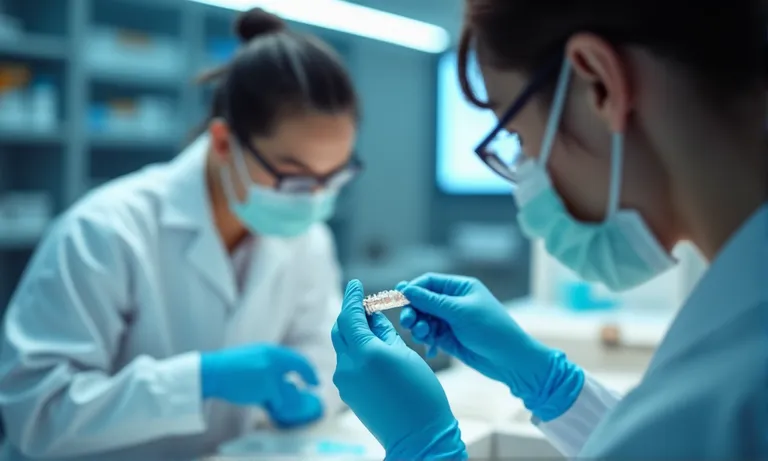
ai-automation-in-crown-bridge-production
Which production steps (design, nesting, QC, printing) benefit most from automation or AI?
AI and rule-based automation are typically embedded into five key phases of crown and bridge production:
- Anatomic design: AI recognizes prep patterns and generates crown morphology based on similar clinical datasets
- Margin line detection: Algorithms accurately define boundaries even in low-contrast scan areas
- Nesting and print planning: Batch layout and material usage are optimized automatically
- Print queue scheduling: Jobs are prioritized for throughput based on deadline and printer type
- Quality control triggers: Predefined tolerances flag deviations during pre-print or post-cure inspection
Labs that integrate these functions typically reduce manual touchpoints by 40–60%.
How do AI-assisted systems differ from entirely manual workflows?
Here’s a high-level comparison:
| Production Step | Manual Workflow | AI/Automated Workflow |
|---|---|---|
| Margin Identification | Technician defines manually | AI suggests lines with confidence scoring |
| Crown Design | Based on library + human adjustment | Auto-generated, requires only final tweak |
| Nesting | Done visually in CAM software | Layout auto-calculated based on part type and resin flow |
| QC Check | Technician inspects deviation | System flags outliers based on training data |
| Scheduling | Admin tracks manually | AI load-balances printers for deadline/capacity |
Automation does not eliminate the technician—it refocuses their role on clinical oversight and exception resolution.
What technologies or platforms (e.g. Dentbird, 3Shape Automate) are used at each stage?
In real-world use, many dental labs rely on hybrid systems. For instance:
A South Korean partner lab of ours recently implemented 3Shape Automate for overnight crown design. Their pre-existing team used to manually process up to 40 units nightly—now, AI handles the bulk of the work, with the team only reviewing flagged exceptions. Their output capacity doubled without additional staff.
Meanwhile, for print batching, Dentbird’s auto-nesting has helped reduce support material waste by over 20%. By clustering similar case types, it also improved post-cure dimensional consistency.
Labs combining platform logic with technician supervision gain both speed and safety—and they become better partners when you need scalability without sacrificing clinical trust.
How Does AI Enhance Design Accuracy and Reduce Manual Planning Time?
AI-driven dental design tools now outperform manual planning in both speed and anatomical precision. From detecting complex margins to generating natural crown morphology, modern platforms significantly reduce case prep time while maintaining high design quality.
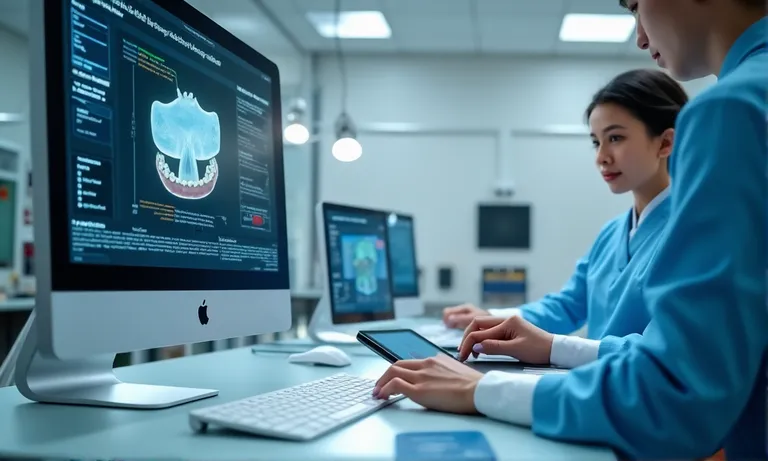
ai-crown-design-margin-detection
How do AI systems identify margin lines and anatomical adaptation in crown design?
Margin detection is one of the most error-prone manual tasks in CAD. AI models trained on thousands of clinical scans can now:
- Auto-segment preparation zones even in low-resolution or moisture-compromised scans
- Predict margin boundaries using contrast, shape priors, and model similarity
- Generate anatomical forms that adapt to the prep surface and occlusal space
- Flag ambiguous areas for manual confirmation, ensuring technician oversight remains
What once required 6–10 minutes of focused work is now completed in under 30 seconds—with revision steps built in.
What accuracy improvements (e.g. <50 μm) are reported in published studies?
Studies consistently show AI-aided design delivers superior consistency. A summary comparison:
| Design Metric | Manual Average | AI-Supported Result | Reference |
|---|---|---|---|
| Margin Line Deviation | ±80–100 μm | ±30–50 μm | HKU 3D-DCGAN study |
| Anatomic Fit Deviation | ±60 μm | <40 μm | IntelliDent Trials, Internal |
| Design Time per Crown (avg.) | 8–12 min | <3 min | Raytops Internal Benchmarks |
When paired with robust scan input, these improvements translate directly to reduced adjustment and remake rates.
Which platforms (e.g. IntelliDent, AI‑DCGAN) offer generative-design capabilities?
One of our Chinese lab partners recently adopted IntelliDent’s auto-margin and AI-shape generation engine. On initial test batches of 50 crowns, the technician team reported over 60% reduction in design time—while noting fewer occlusal adjustment complaints from clients.
Their previous workflow relied on template-based morphology, which often required manual smoothing and line revisions. With AI-guided adaptation, most cases now require only minor contact adjustments before approval.
Meanwhile, academic platforms like HKU’s 3D-DCGAN show that deep generative models can produce highly realistic morphology, even when starting from incomplete scan data.
The takeaway? AI isn’t just faster—it introduces a new level of design confidence that scales.
How Does Automated Workflow Improve Printing Scheduling, Nesting, and Batch Delivery?
AI-powered batch planning and automated nesting have become key drivers of scale in modern dental labs. By offloading repetitive setup tasks—like layout optimization, support structure generation, and print order scheduling—labs can increase throughput without adding headcount or risking burnout on late-day shifts.
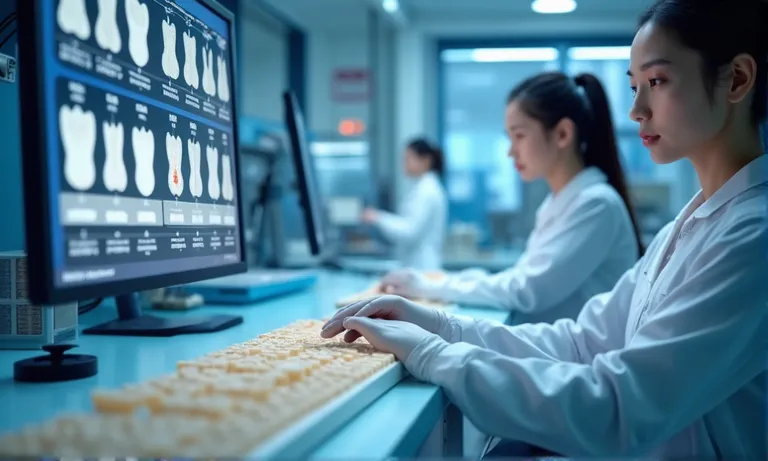
ai-automated-nesting-batch-printing
How does automation streamline nest layout for 3D printing or milling?
A typical automated nesting workflow includes:
- Scan intake: All STL files are verified for orientation, surface errors, and part type
- Auto-grouping: Similar units (e.g., temp crowns, frameworks) are clustered by resin type
- Plate layout optimization: Nesting software arranges parts for maximal density and uniform resin flow
- Support generation: System calculates ideal support points and minimizes post-processing contact
- Printer load assignment: Cases are assigned to specific printers based on material, urgency, and prior load
What used to take 30–45 minutes per batch can now be handled in under 10 minutes with full traceability.
How are cases auto-scheduled to optimize batch throughput?
| Scheduling Factor | Manual Workflow | AI-Driven Workflow |
|---|---|---|
| Job Priority Assignment | Technician discretion | Based on deadline, material queue, and SLA rules |
| Printer Allocation | Visual/manual matching | Load-balanced using printer capacity + resin type |
| Reprint Catch-Up | Reactive rescheduling | Auto-inserted into next available slot |
| Nighttime Queue Setup | Done pre-shift manually | Preloaded for auto-launch at 2 AM (example) |
Smart automation enables 24/7 production, particularly when combined with curing automation and RFID-based tray tracking.
What efficiencies are reported by labs using overnight or bulk design tools?
One of our East European lab clients implemented Dentbird Batch and auto-scheduling to reduce technician layout work. Their team previously managed printing setup in two 4-hour blocks per day. Post-automation, nesting and scheduling are now completed in 30 minutes total—including QC stage bundling and post-cure stacking.
More importantly, batch-level defect rates dropped by 18% due to better resin grouping and pre-cure heat alignment.
They also noted that by flagging “late-day emergency” jobs through the scheduling layer, same-day delivery rates rose 9% without requiring overtime.
When integrated correctly, automated workflows don’t just increase print volume—they improve consistency and team capacity.
How Are AI and Automation Applied to Quality Control and Consistency Monitoring?
AI-based quality control isn’t just about catching errors—it’s about building traceable, repeatable systems that scale with volume. From deviation mapping to batch-level analytics, AI tools can now flag problems before delivery, not after chairside adjustment.
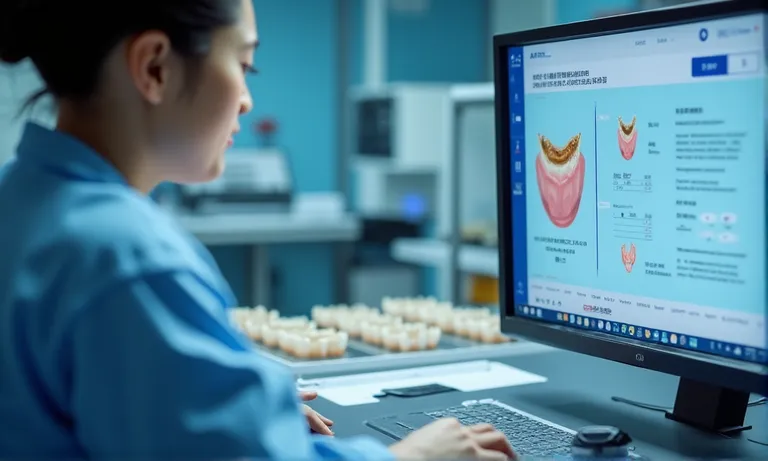
ai-qc-crown-bridge-restorations
How does AI detect anomalies before final restoration delivery?
Modern labs integrate machine learning at key checkpoints to:
- Compare STL vs. printed model geometry with sub-50 μm resolution
- Highlight tolerance violations (e.g., tight contact, overmilled occlusals) visually
- Trigger technician review only when needed, reducing unnecessary time spent on “normal” cases
- Build historical defect mapping, helping identify recurring margin issues or printer drift
Some platforms also cross-reference implant library data or connector strength ranges for bridge units.
What remake or adjustment rate reduction have labs achieved using AI QC?
| Metric | Before AI QC | After AI QC | Notes |
|---|---|---|---|
| Average Crown Remake Rate | 5–6% | <2% | Based on Dentbird + Catalis deployment reports |
| Chairside Occlusal Adjustments | 15–18% | <7% | Per technician logs in multi-unit cases |
| Case Blocking Rate (Pre-delivery) | 3.5% | >7% | AI blocks more—but avoids clinical problems |
Blocking more cases may sound worse—but in reality, it prevents high-cost post-delivery failures and maintains clinician trust.
How does automated inspection support batch-to-batch consistency?
One of our German partner labs recently deployed a VCAD system to track deviation trends across implant-supported crown batches. They had recurring chairside complaints from two clinics—but inconsistent reports.
By tagging every print with deviation maps and QC status, they traced the issue to a single under-cured resin batch affecting 14 crowns. Once isolated, that material was withdrawn, and a new print validation protocol was implemented for all multi-unit cases.
Since then, batch-level remake rates dropped from 5.2% to 1.4%, and the clinic reported a 70% drop in chairside adjustments.
The point isn’t perfection—it’s predictability. Labs using AI-based QC can fail faster, fix faster, and build accountability over time.
What Operational and Clinical Outcomes Are Improved Through AI and Automation?
AI is only meaningful if it improves measurable outcomes. From design time to clinical fit, labs adopting automation report gains not just in speed—but in predictability, staffing, and satisfaction metrics that affect long-term partnerships.
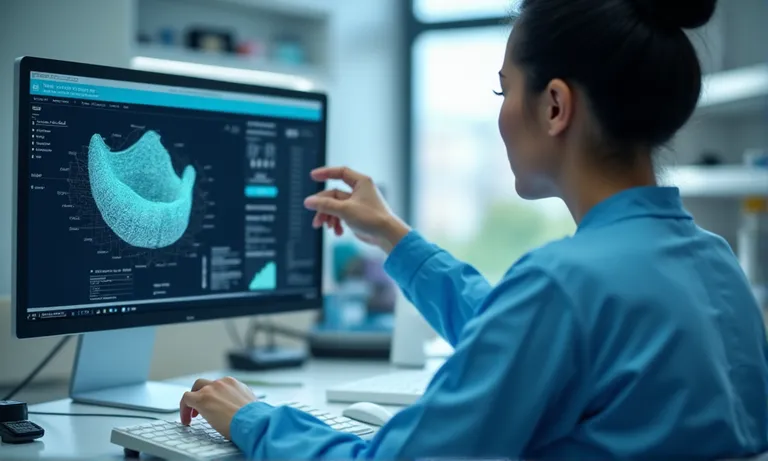
ai-crown-design-efficiency-roi
How much time is saved vs traditional workflows?
| Process Step | Manual Average | With AI/Automation | Savings |
|---|---|---|---|
| Crown Design (single) | 12–15 min | 3–4 min | ~70% faster |
| Print Nesting Setup | 30–45 min/batch | 5–10 min/batch | ~80% faster |
| QC Review (full arch) | 25 min | 6–10 min (AI triaged) | ~60% faster |
| Chairside Adjustment Time | 5–7 min/unit | <2 min/unit (avg) | ~60% less time |
These savings free up experienced staff to focus on complex cases or customer support—while enabling scale without burnout.
How do AI systems impact clinical consistency and satisfaction?
- Fewer remakes: Labs using AI QC or auto-design tools report remake rates dropping from 5–6% to under 2%
- Better fits: Occlusal and margin accuracy often exceed manual benchmarks (e.g. sub-50 μm tolerances)
- Improved trust: Doctors notice the consistency—especially when units from the same batch show near-identical fit
- Workflow peace of mind: Auto-scheduling reduces rush panic, especially on short-deadline or high-volume weeks
While clinicians don’t always see “how” automation works, they definitely feel the results in chairside performance.
What real-world metrics support these outcomes?
A U.S.-based lab running Glidewell’s CrownAI recently passed 200+ single units/day with only 4 full-time designers—thanks to AI-powered crown generation and batch post-processing.
Before automation, the same volume required 10–12 staff. Not only did labor cost drop, but chairside fit rates improved by 22%, and adjustment time per unit fell to under 90 seconds.
They also noted their average order-to-delivery time went from 3.8 days to 2.2—allowing same-week delivery for 70% of crown cases.
This kind of performance gives sales teams a credible promise—and clinicians a reliable experience.
How Can Buyers Assess a Lab’s Level of AI and Automation Integration?
As more labs market “AI-powered” production, it becomes harder to separate buzzwords from real capabilities. For procurement teams, asking the right questions—and interpreting the answers—can reveal whether automation is embedded in daily operations or just mentioned in brochures.
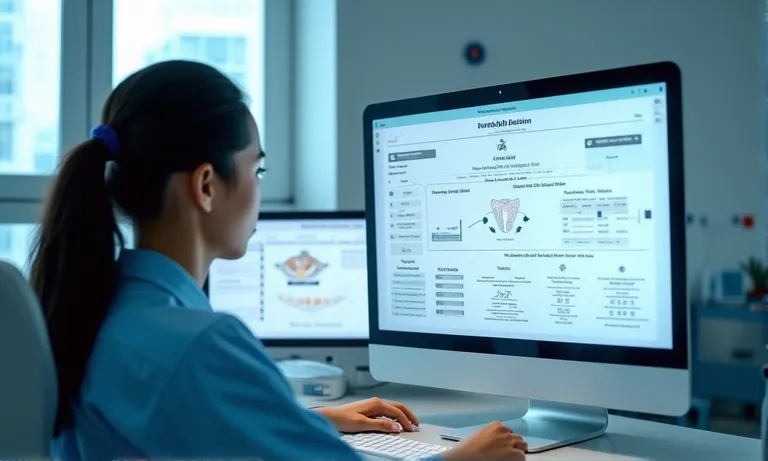
ai-integration-lab-evaluation
What questions reveal if a lab truly uses AI or automation?
- Which design steps are automated? Ask for specifics: margin detection, anatomical generation, connector spacing
- How is QC handled? Look for visual deviation reports, auto-flagged cases, or batch inspection protocols
- What software licenses are active? Platforms like 3Shape Automate, Dentbird, or VCAD often indicate integration
- Can they show daily usage data? Reports or dashboards showing volume, adjustment rates, AI acceptance metrics
- Who oversees AI oversight? Mature labs usually designate a digital lead or QA engineer, not just rely on vendors
These answers separate labs who truly operationalize AI—from those still outsourcing or testing.
How can buyers tell real AI integration from surface-level claims?
| Evaluation Criteria | Truly Integrated Lab | Surface-Level Claim |
|---|---|---|
| Platform Access | Full license + in-house implementation | Mentions AI vendor in passing |
| Case Evidence | Can show daily flagged/approved cases | No tracked AI decisions |
| QC Reporting | Shows deviation/inspection history | Manual QC with no AI layer |
| Team Roles | Has digital lead or AI-trained staff | Still relies fully on technicians |
| Process Transparency | Offers to walk through case tracking | Talks general “digital workflow” |
Labs that actually use AI don’t just “say digital”—they demonstrate it in how they quote, plan, produce, and respond.
What case samples or client feedback help validate this?
One of our DSO clients in Australia needed to audit a sub-contracted lab’s automation claims before onboarding. They’d received a proposal filled with AI buzzwords—but no details.
We helped the client ask for 3 actual crown cases showing:
- CAD timestamps
- Nesting schedules
- QC deviation reports
- Post-delivery adjustment logs
Only two cases could be provided—and none showed AI triage or QC automation. Based on that, the DSO paused onboarding and requested further validation.
The experience reinforced this insight: if a lab can’t walk you through one AI-verified case from start to finish, it’s likely not production-ready at scale.
Conclusion
AI and automation are not just future trends—they’re active performance drivers in crown and bridge manufacturing today. Labs that embed these technologies across design, production, and QC are better positioned to offer faster turnaround, greater consistency, and scalable collaboration.
For buyers—from independent clinics to procurement teams at DSOs—partnering with a digitally mature lab means gaining not only technical advantages but also a smoother, more predictable workflow. As an overseas dental lab deeply involved in supporting such transitions, we’ve seen firsthand how the right digital systems translate into real operational outcomes.
When evaluating potential partners, look beyond claims and focus on measurable results, transparent systems, and collaborative support. That’s where long-term trust is built.


